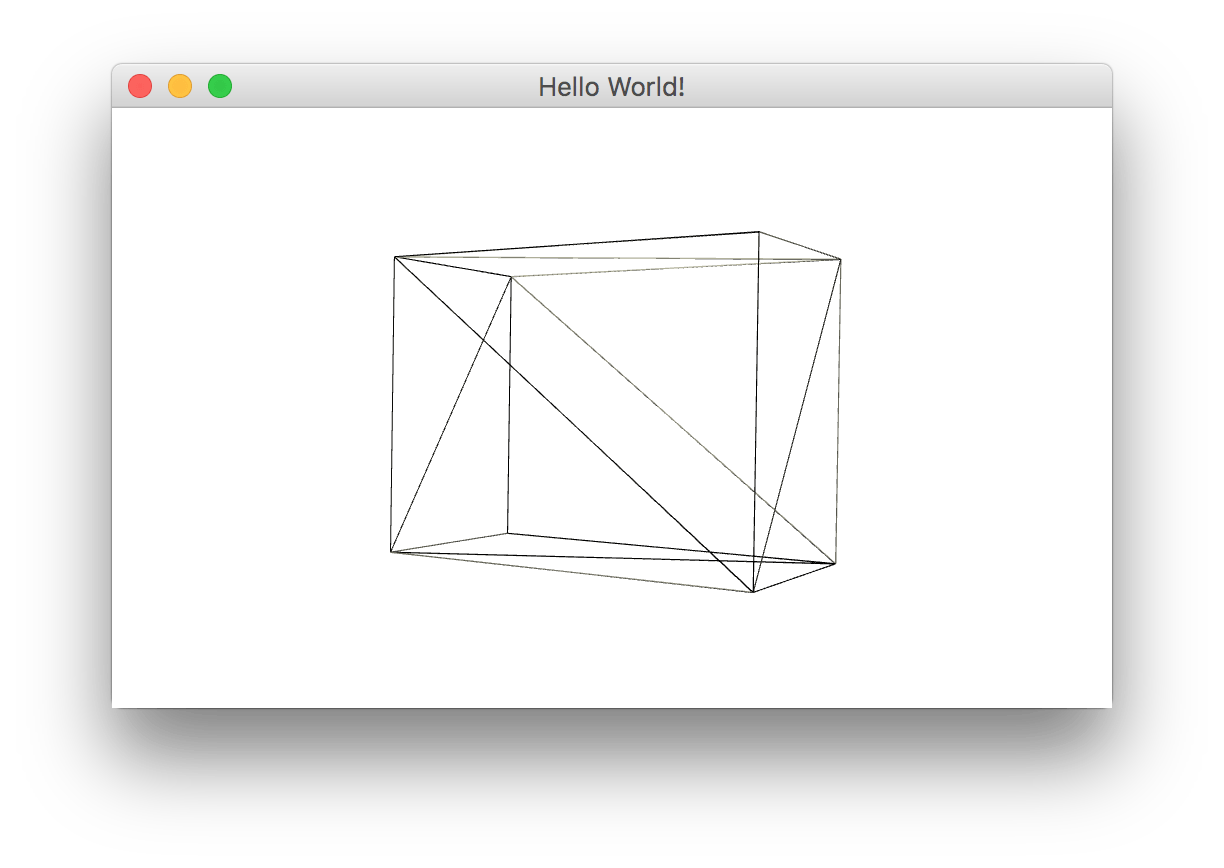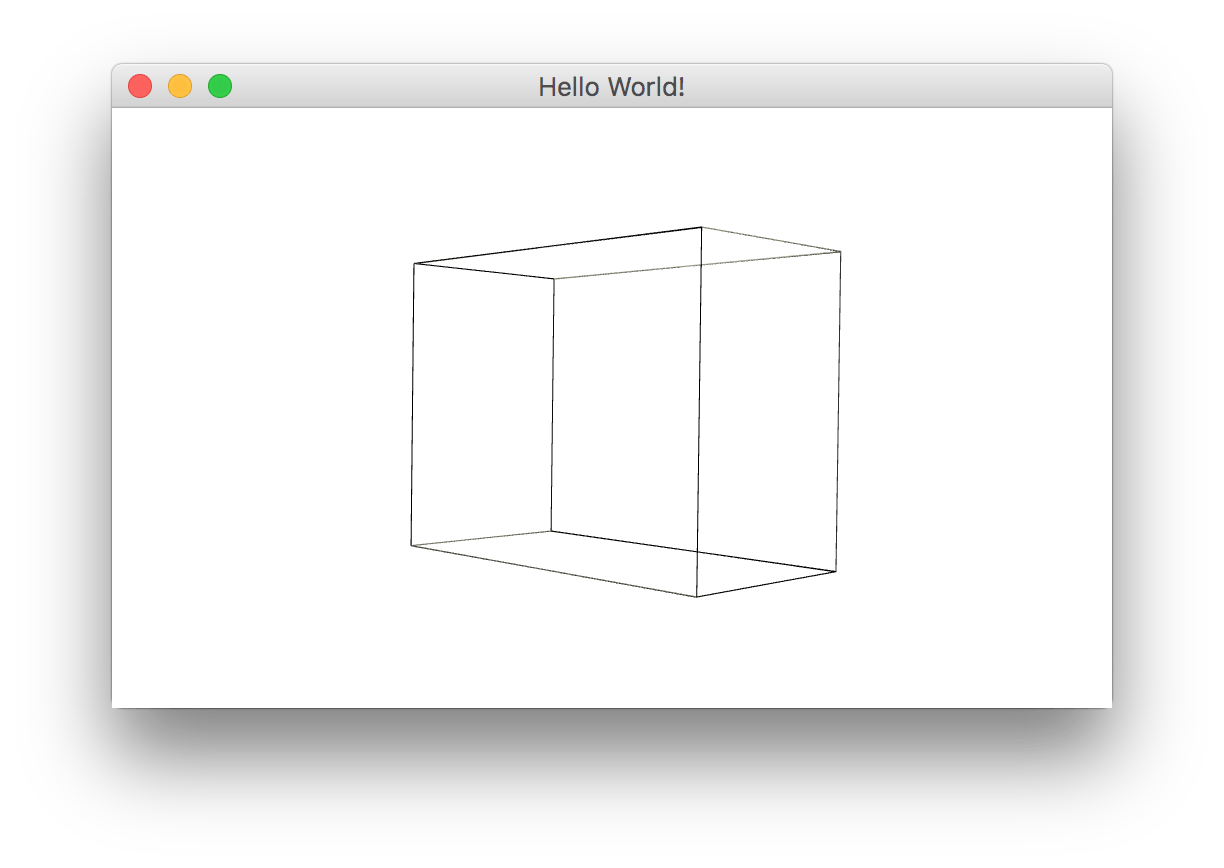Javafx Четырехсторонняя сетка
Мне нужно отобразить четырехугольную сетку в javafx для каждой грани сетки, имеющей 4 точки. Я пробовал некоторые примеры треугольных сеток из библиотеки fxyz, но не уверен, как это работает для четырехугольников. Может ли кто-нибудь помочь указать на примеры в javafx для четырехугольной сетки.
1 ответ
Проект 3DViewer, доступный в репозитории OpenJFX, уже содержит PolygonalMesh реализация, которая позволяет любое количество точек на грани, так что любой многоугольник может быть гранью.
Вы можете использовать их, что реализация сетки в PolygonMeshViewвместо штатного MeshView,
Поскольку треугольник является допустимым многоугольником, любой TriangleMesh может быть легко использован в качестве PolygonMesh,
Например, CuboidMesh из библиотеки FXyz имеет следующую реализацию, предполагая PolygonMesh:
private PolygonMesh getTriangleMesh(float width, float height, float depth) {
float L = 2f * width + 2f * depth;
float H = height + 2f * depth;
float hw = width/2f, hh = height/2f, hd = depth/2f;
float[] points = new float[] {
hw, hh, hd, hw, hh, -hd,
hw, -hh, hd, hw, -hh, -hd,
-hw, hh, hd, -hw, hh, -hd,
-hw, -hh, hd, -hw, -hh, -hd
};
float[] texCoords = new float[] {
depth / L, 0f, (depth + width) / L, 0f,
0f, depth / H, depth / L, depth / H,
(depth + width) / L, depth / H, (2f * depth + width) / L, depth/H,
1f, depth / H, 0f, (depth + height) / H,
depth / L, (depth + height)/H, (depth + width) / L, (depth + height) / H,
(2f * depth + width) / L, (depth + height) / H, 1f, (depth + height) / H,
depth / L, 1f, (depth + width) / L, 1f
};
int[][] faces = new int[][] {
{0, 8, 2, 3, 1, 7}, {2, 3, 3, 2, 1, 7},
{4, 9, 5, 10, 6, 4}, {6, 4, 5, 10, 7, 5},
{0, 8, 1, 12, 4, 9}, {4, 9, 1, 12, 5, 13},
{2, 3, 6, 4, 3, 0}, {3, 0, 6, 4, 7, 1},
{0, 8, 4, 9, 2, 3}, {2, 3, 4, 9, 6, 4},
{1, 11, 3, 6, 5, 10}, {5, 10, 3, 6, 7, 5}
};
int[] smooth = new int[] {
1, 1, 2, 2, 3, 3, 4, 4, 5, 5, 6, 6
};
PolygonMesh mesh = new PolygonMesh(points, texCoords, faces);
mesh.getFaceSmoothingGroups().addAll(smooth);
return mesh;
}
Это дает следующий результат:
private double mouseOldX, mouseOldY = 0;
private final Rotate rotateX = new Rotate(0, Rotate.X_AXIS);
private final Rotate rotateY = new Rotate(0, Rotate.Y_AXIS);
@Override
public void start(Stage primaryStage) {
PolygonMeshView meshView = new PolygonMeshView(getTriangleMesh(100, 150, 200));
meshView.setDrawMode(DrawMode.LINE);
meshView.setCullFace(CullFace.NONE);
meshView.setMaterial(new PhongMaterial(Color.LIGHTYELLOW));
Scene scene = new Scene(new Group(meshView), 500, 300, true, SceneAntialiasing.BALANCED);
scene.setOnMousePressed(event -> {
mouseOldX = event.getSceneX();
mouseOldY = event.getSceneY();
});
scene.setOnMouseDragged(event -> {
rotateX.setAngle(rotateX.getAngle() - (event.getSceneY() - mouseOldY));
rotateY.setAngle(rotateY.getAngle() + (event.getSceneX() - mouseOldX));
mouseOldX = event.getSceneX();
mouseOldY = event.getSceneY();
});
PerspectiveCamera camera = new PerspectiveCamera(false);
camera.setNearClip(0.1);
camera.setFarClip(10000.0);
camera.getTransforms().addAll(rotateX, rotateY, new Translate(-250, -150, 0));
scene.setCamera(camera);
primaryStage.setTitle("Hello World!");
primaryStage.setScene(scene);
primaryStage.show();
}
Но если мы объединим треугольники граней в одних и тех же сторонах призмы, мы можем легко создать четырехугольные грани. Обратите внимание, что points а также texCoords оставаться прежним:
private PolygonMesh getQuadrilateralMesh(float width, float height, float depth) {
float L = 2f * width + 2f * depth;
float H = height + 2f * depth;
float hw = width/2f, hh = height/2f, hd = depth/2f;
float[] points = new float[] {
hw, hh, hd, hw, hh, -hd,
hw, -hh, hd, hw, -hh, -hd,
-hw, hh, hd, -hw, hh, -hd,
-hw, -hh, hd, -hw, -hh, -hd
};
float[] texCoords = new float[] {
depth / L, 0f, (depth + width) / L, 0f,
0f, depth / H, depth / L, depth / H,
(depth + width) / L, depth / H, (2f * depth + width) / L, depth/H,
1f, depth / H, 0f, (depth + height) / H,
depth / L, (depth + height)/H, (depth + width) / L, (depth + height) / H,
(2f * depth + width) / L, (depth + height) / H, 1f, (depth + height) / H,
depth / L, 1f, (depth + width) / L, 1f
};
int[][] faces = new int[][] {
{0, 8, 2, 3, 3, 2, 1, 7},
{4, 9, 5, 10, 7, 5, 6, 4},
{0, 8, 1, 12, 5, 13, 4, 9},
{2, 3, 6, 4, 7, 1, 3, 0},
{0, 8, 4, 9, 6, 4, 2, 3},
{1, 11, 3, 6, 7, 5, 5, 10}
};
int[] smooth = new int[] {
1, 2, 3, 4, 5, 6
};
PolygonMesh mesh = new PolygonMesh(points, texCoords, faces);
mesh.getFaceSmoothingGroups().addAll(smooth);
return mesh;
}
Это будет использоваться как:
@Override
public void start(Stage primaryStage) {
PolygonMeshView meshView = new PolygonMeshView(getQuadrilateralMesh(100, 150, 200));
...
}
давая ожидаемый результат:
Обратите внимание, что для этого образца каждая грань использует точки и индексы текстуры, но вы также можете добавить обычные индексы.

